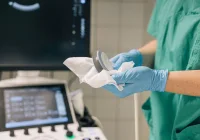Climate, health and competitiveness are converging pressures on European healthcare, with medical technology central to both the challenge and the solution. According to MedTech Europe, healthcare generates about 5% of global greenhouse gas emissions. Medical technology accounts for an estimated 15–25% of that footprint, equivalent to roughly 1% of global emissions.
The EU Climate Law sets a legally binding pathway to economy-wide net zero by 2050, with stringent milestones for 2030 and 2040. For the sector, most emissions sit in Scope 3 across complex, multi-tiered supply chains, yet there is significant near-term abatement available at low cost. A practical route combines immediate operational levers with broader system change in regulation, procurement and collaboration to sustain innovation, resilience and patient access.
Emissions Landscape and Industry Pressures
Healthcare’s climate footprint is material at 2.5 gigatonnes CO2, placing the sector on par with major emitting nations. Within that, MedTech contributes 15–25% of emissions across raw materials, manufacturing, distribution, use and end-of-life, with the upstream supply chain responsible for the largest share. Decarbonising MedTech therefore becomes a necessary step toward decarbonising healthcare while safeguarding access to life-saving and life-sustaining technologies. The EU’s target of net zero by 2050 and associated measures, including carbon pricing and product-related regulations, intensify the imperative.
The business case is strengthening. Customers are building sustainability into tenders, with requirements tightening across Europe and beyond. Investors are integrating sustainability into capital allocation and employees increasingly weigh environmental performance in career decisions. Companies that improve environmental performance are better placed to compete in tenders, attract capital and talent and open new revenue streams in services, refurbishment and circular models where permitted. At the same time, the carbon costs of inaction are rising through mechanisms such as the Emissions Trading System and the Carbon Border Adjustment Mechanism, alongside physical and supply chain risks. Analysis indicates that in plausible scenarios by 2035, risks from inaction could erode a material share of operating profit, while the average cost to decarbonise upstream product supply chains to the point of sale remains modest at around 5% of sold goods cost.
Must Read: Driving Decarbonisation in Health Systems
Progress, however, is uneven. Scope 1 and 2 disclosures are common, but Scope 3 baselining remains weak, often relying on spend-based methods rather than activity-based or supplier-specific primary data. Supplier engagement is nascent, with limited consequence management or co-investment. The sector is dominated by SMEs that face resource and capability constraints, long product development cycles and varied regulatory interpretations across markets. These realities reinforce the need for a coordinated approach that aligns industrial policy, procurement and technical standards with patient safety and innovation.
Immediate Levers That Cut Emissions at Low Cost
A large share of abatement can be captured quickly by actions that are cost-effective and feasible without regulatory recertification. Switching to renewable electricity through on-site generation, power purchase agreements or virtual contracts can lower emissions and, for many regions, reduce energy costs in common. Efficiency measures in manufacturing and logistics, including energy management systems, process optimisation and modal shifts from air to shipping or rail, reduce both emissions and operating costs. Green heat solutions such as industrial heat pumps can address a significant portion of heat demand at temperatures below 100°C in operations, with upstream suppliers requiring additional pathways for higher temperatures.
Logistics and network optimisation curb transport emissions while improving service reliability. Where feasible, switching transport fuels or modes provides further reductions. Hospitals and care settings can also benefit from lower use-phase emissions when devices are designed to be more energy-efficient, delivering operational savings that strengthen purchasing cases for lower-carbon options. To unlock these levers at speed and scale, companies need reliable access to clean energy, workable data-sharing tools across value chains and a regulatory environment that enables access to long-term green power agreements.
Supplier engagement is fundamental because 90–95% of emissions are typically outside direct control. Clear tender criteria, supplier education and performance incentives can accelerate change, although MedTech’s limited share of demand for many global raw materials constrains individual leverage. Collaborative initiatives and buying groups can pool demand and standardise expectations, supporting deployment of mature technologies and signalling the market for low-carbon inputs.
Design, Circularity and The Harder-To-Reach Abatement
Beyond operational measures, product and packaging design can deliver roughly a further quarter of the pathway, though some changes face regulatory and practical hurdles. Dematerialisation reduces the volume of materials used and waste at end-of-life, often lowering costs. Increasing recycled content is feasible for secondary and tertiary packaging and some components where safety allows, while closed-loop systems for glass, aluminium and plastics can cut emissions and costs. Designing for longevity, repair and disassembly enables refurbishment and parts replacement, reducing lifetime impacts and opening service-oriented revenue models. Energy-efficient product designs also reduce emissions in the use phase while supporting customer value.
Recycling, refurbishment and reprocessing can contribute where contamination risks, national rules and safety standards permit. Take-back schemes require scale and infrastructure, and not all single-use devices can be reprocessed. Progress is typically faster in packaging than in primary product changes because primary packaging and core components often require extensive validation and testing. Standardising life-cycle assessment methods tailored to MedTech would enable fair product comparisons and support value-based procurement. An effective internal market for waste, robust quality standards for recycled materials and capacity building for purchasers would further lower barriers.
The remaining abatement is split between solutions that are currently uneconomic and those that are both costly and blocked by regulation. Upstream decarbonisation of core raw materials may rely on high-temperature process changes, carbon capture or new fuels that remain subscale and expensive. Some lower-carbon materials and processes face regulatory barriers that need structured dialogue to resolve without compromising patient and user safety. Harmonising requirements across countries can reduce costs and accelerate scale. Governments and regulators have a role in accelerating clean energy deployment, supporting technology scale-up and aligning horizontal sustainability legislation with sector-specific rules to avoid conflicting demands.
A credible route to net zero for MedTech combines near-term, low-cost operational levers with targeted product and packaging redesign, all underpinned by stronger supplier engagement and shared standards. The cost of upstream decarbonisation is manageable, whereas the cost of inaction is mounting through regulation, supply chain disruption and physical risks. Progress on Scope 3 transparency, collaborative procurement and enabling regulation will determine the pace at which companies close the gap to a 1.5-degree pathway. Ensuring patient safety while aligning energy access, data tools and procurement incentives can accelerate emissions reductions and reinforce competitiveness, resilience and access to high-quality care.
Source: MedTech Europe
Image Credit: iStock










